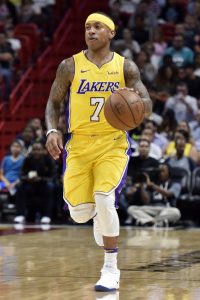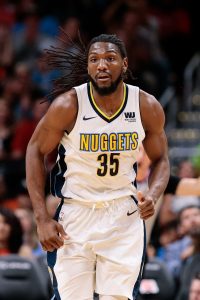After a relatively quiet day in terms of NBA transactions on Thursday, a flurry of agreements were reached in the evening. The Nuggets‘ free agent deal with veteran guard Isaiah Thomas kicked off a series of moves that saw Denver agree to send Kenneth Faried and Darrell Arthur to Brooklyn, with the Nets flip Jeremy Lin to the Hawks in order to create the cap room necessary to absorb the Nuggets’ unwanted contracts.
As we detailed on Thursday, the Hawks and Nets were two of the only teams with any cap room still available. The Nuggets, meanwhile, entered Thursday with one of the NBA’s highest projected payrolls, and were looking for a way to get out of luxury-tax territory. The 2018/19 cap outlooks for all three teams were altered significantly by last night’s trade agreements.
With the help of salary data from Basketball Insiders and information from cap experts Bobby Marks and Albert Nahmad, here’s a breakdown of how each team involved in last night’s action will be impacted from a cap – and tax – perspective:
Atlanta Hawks
There are a few factors to consider when determining exactly how much cap room the Hawks still have available. For one, we’re still not sure whether or not Lin is waiving his trade kicker as part of his move to Atlanta. If he doesn’t waive that trade kicker – and he’d have no real reason to – his bonus will increase his cap hit from $12.5MM to $13.75MM, cutting into the Hawks’ cap space.
Atlanta also still has Jaylen Morris and Antonius Cleveland under contract. Both players are on modest non-guaranteed salaries worth $1.38MM apiece.
If we assume that Lin’s trade kicker will increase his cap hit and Morris and Cleveland remain on the Hawks’ roster, the team projects to have about $7.7MM in cap space remaining. However, that number would increase to nearly $10.5MM without Morris and Cleveland.
Brooklyn Nets
Most of the Nets‘ leftover cap room will be eaten up by Faried’s and Arthur’s salaries. After Brooklyn completes its reported deal with second-round pick Rodions Kurucs, the team will have less than $3MM in cap space available.
The Nets still haven’t finalized their contract agreements with Joe Harris and Ed Davis, since it makes sense to use up all their cap room before they use their Early Bird rights to go over the cap for Harris and sign Davis with the room exception.
If Brooklyn determines that it will have no use for its remaining $2-3MM in cap space, the club could complete those signings after officially locking up Kurucs. However, GM Sean Marks figures to explore all options with that leftover cap room before going over the cap by signing Harris and Davis.
Denver Nuggets
There are plenty of moving parts in play for the Nuggets, who still have to finalize Thomas’ signing and waive Isaiah Whitehead, whose non-guaranteed contract will be acquired in the trade with the Nets. We also don’t have final, official figures for new contracts for Nikola Jokic, Will Barton, and Jarred Vanderbilt.
Based on what we know though, it appears the Nuggets will have a team salary of about $115MM after waiving Whitehead and signing Thomas, putting the team approximately $8.7MM below the tax line.
As Nahmad observes (via Twitter), Denver has a few unlikely incentives to consider for Jokic, Paul Millsap, and Gary Harris. The 2018/19 cap hits for those players would increase if they earn their incentives, so the Nuggets will want to leave a little breathing room to account for that. Still, the team has flexibility to use its full mid-level exception.
So far, the Nuggets have used a reported $2.84MM of their mid-level to sign Torrey Craig and Vanderbilt, which would leave about $5.8MM of the $8.64MM exception available. Denver could also technically use its $3.382MM bi-annual exception, though the team would become hard-capped if it uses any of its BAE or uses more than the taxpayer portion ($5.337MM) of the mid-level.

